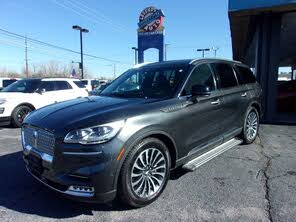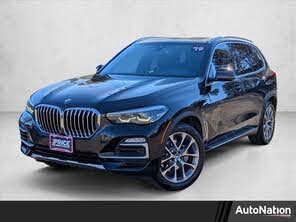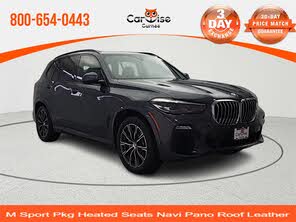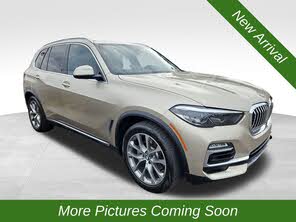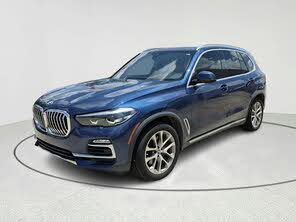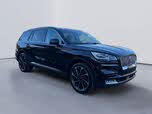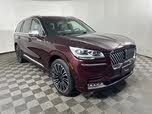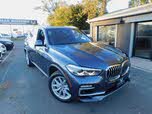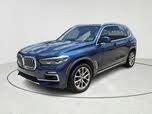2020 Lincoln Aviator vs 2019 BMW X5
Overview | |
MSRP$60,700 | MSRP$51,100 |
Listings774 | Listings589 |
Ratings & Reviews | |
User Reviews | User Reviews |
Expert reviews7.8 out of 10 | Expert reviews8.2 out of 10 |
Pros
Cons
| |
2019 BMW X5 Reviews SummaryThe BMW X5 redefined SUVs 20 years ago, leaning into the idea that you could have truck form and car function all in one package. In fact, BMW branded the original X5 as an SAV—a Sport Activity Vehicle—to help emphasize the fact that it drove as well as the company's famous sport sedans. And while that claim was a bit of an overreach, the original X5 did outperform its SUV competitors on the road. Now in its fourth generation, BMW’s midsize crossover continues to deliver on that two-decade-old promise: The X5 delivers car-like handling in an SUV form. And while the 2019 X5 stretches 1 inch longer, 3 inches wider, and 1 inch taller than last year's model, you’d have to look closely to notice the differences. Most obvious is a new and bigger kidney grille with active shutters. It has already received flak for being “comically large,” though in my opinion, it seems proportional to the rest of the vehicle—enough to make me wonder if the grilles on previous iterations of the X5 were too small. Inside, you’ll find a redesigned interior with an updated version of the iDrive system, and a suite of Level 2 autonomous technology that unfortunately leaves a lot to be desired. But that shouldn’t dissuade you from BMW’s revolutionary recreational vehicle, because there’s still a lot to love. | |
2020 Lincoln Aviator Reviews SummaryThe heyday for Lincoln was more than a half-century ago. Those postwar years of prosperity and optimism were the perfect time for cars like the Continental and others. They delivered comfort and luxury, wrapped in midcentury modern styling. Even as recently as the 1990s, Lincoln was still a popular brand, riding the SUV craze with its Navigator. But after the turn of the century, Lincoln lost its ability to create new designs and looked inward and backward. Sure, retro-themed cars like the redesigned Mustang, PT Cruiser, and Chevy HHR had turned some heads, but none of those came from luxury brands. The BMWs and Mercedes of the world were all looking forward and pushing the envelope for contemporary automotive design. Meanwhile, Lincoln offered the MKX, which was based on the Ford Edge and featured ’66 Continental styling. Neat in a vacuum, but off-base compared to the modern luxury market. This experimental phase with various retro looks coincided with the move to the MK-# alphabet-soup naming convention and big improvements in the Ford lineup, where top-end trims of the Fusion overlapped with an entry-level trim of the MKZ. The combination left Lincoln a confusing, anonymous afterthought in the modern luxury game. But Lincoln is finally ready to change all that. It has a new cohesive design language, its focus is once again on luxury, and the three-letter naming convention that never meant anything to anyone other than Lincoln marketers is gone. The brand led with the 2017 Continental and 2018 Navigator, which are each impressive in their own right. But the company's lineup is growing and now includes the all-new 2020 Lincoln Aviator. Named after a luxury variant of the 2002-2005 Ford Explorer, this new Aviator is also based on the contemporary Explorer platform, but it's a luxury vehicle in its own right. Much of the success of the Lincoln brand may hinge on this midsize, 3-row luxury SUV, so you need to consider its competition, such as the Audi Q7, Infiniti QX60, and all-new Cadillac XT6. Read on to learn if Lincoln’s take on luxury will stand out in a crowded competitive field. | |
Popular Features & Specs | |
Engine3.0L 335 hp I6 | Engine3.0L 400 hp V6 |
Drive TrainAWD | Drive TrainRWD |
Seating Capacity7 | Seating Capacity7 |
Horsepower335 hp @ 5500 rpm | Horsepower |
MPG City20 | MPG City18 |
MPG Highway26 | MPG Highway26 |
Engine | |
Engine Name3.0L 335 hp I6 | Engine Name3.0L 400 hp V6 |
Torque330 lb-ft @ 1500 rpm | Torque |
Horsepower335 hp @ 5500 rpm | Horsepower |
DrivetrainAWD | DrivetrainRWD |
Fuel Economy | |
MPG City20 | MPG City18 |
MPG Highway26 | MPG Highway26 |
Interior | |
Seating Capacity7 | Seating Capacity7 |
Key Features | |
Navigation SystemStandard | Navigation System |
Sunroof/MoonroofStandard | Sunroof/Moonroof |
Safety | |
Front Crash Overall4 | Front Crash Overall5 |
Side Crash Overall5 | Side Crash Overall5 |
Dimensions & Capacity | |
Cargo Space33.9 cu ft | Cargo Space18.3 cu ft |
Curb Weight4813 lbs | Curb Weight4764 lbs |
Height69.0 in | Height69.8 in |
Length194.3 in | Length199.3 in |
Width87.3 in | Width89.9 in |
Wheelbase117.1 in | Wheelbase119.1 in |
Maximum Payload849 lbs | Maximum Payload |
Number of doors4 | Number of doors4 |
Maximum Towing Capacity7209 lbs | Maximum Towing Capacity |
Standard Towing Capacity6603 lbs | Standard Towing Capacity |
Overview | ||
MSRP | $60,700 | $51,100 |
Listings | ||
Ratings & Reviews | ||
User reviews | ||
Expert reviews | 7.8 out of 10Read full review | 8.2 out of 10Read full review |
Pros & cons | Pros
Cons
| |
Summary | The BMW X5 redefined SUVs 20 years ago, leaning into the idea that you could have truck form and car function all in one package. In fact, BMW branded the original X5 as an SAV—a Sport Activity Vehicle—to help emphasize the fact that it drove as well as the company's famous sport sedans. And while that claim was a bit of an overreach, the original X5 did outperform its SUV competitors on the road. Now in its fourth generation, BMW’s midsize crossover continues to deliver on that two-decade-old promise: The X5 delivers car-like handling in an SUV form. And while the 2019 X5 stretches 1 inch longer, 3 inches wider, and 1 inch taller than last year's model, you’d have to look closely to notice the differences. Most obvious is a new and bigger kidney grille with active shutters. It has already received flak for being “comically large,” though in my opinion, it seems proportional to the rest of the vehicle—enough to make me wonder if the grilles on previous iterations of the X5 were too small. Inside, you’ll find a redesigned interior with an updated version of the iDrive system, and a suite of Level 2 autonomous technology that unfortunately leaves a lot to be desired. But that shouldn’t dissuade you from BMW’s revolutionary recreational vehicle, because there’s still a lot to love. | The heyday for Lincoln was more than a half-century ago. Those postwar years of prosperity and optimism were the perfect time for cars like the Continental and others. They delivered comfort and luxury, wrapped in midcentury modern styling. Even as recently as the 1990s, Lincoln was still a popular brand, riding the SUV craze with its Navigator. But after the turn of the century, Lincoln lost its ability to create new designs and looked inward and backward. Sure, retro-themed cars like the redesigned Mustang, PT Cruiser, and Chevy HHR had turned some heads, but none of those came from luxury brands. The BMWs and Mercedes of the world were all looking forward and pushing the envelope for contemporary automotive design. Meanwhile, Lincoln offered the MKX, which was based on the Ford Edge and featured ’66 Continental styling. Neat in a vacuum, but off-base compared to the modern luxury market. This experimental phase with various retro looks coincided with the move to the MK-# alphabet-soup naming convention and big improvements in the Ford lineup, where top-end trims of the Fusion overlapped with an entry-level trim of the MKZ. The combination left Lincoln a confusing, anonymous afterthought in the modern luxury game. But Lincoln is finally ready to change all that. It has a new cohesive design language, its focus is once again on luxury, and the three-letter naming convention that never meant anything to anyone other than Lincoln marketers is gone. The brand led with the 2017 Continental and 2018 Navigator, which are each impressive in their own right. But the company's lineup is growing and now includes the all-new 2020 Lincoln Aviator. Named after a luxury variant of the 2002-2005 Ford Explorer, this new Aviator is also based on the contemporary Explorer platform, but it's a luxury vehicle in its own right. Much of the success of the Lincoln brand may hinge on this midsize, 3-row luxury SUV, so you need to consider its competition, such as the Audi Q7, Infiniti QX60, and all-new Cadillac XT6. Read on to learn if Lincoln’s take on luxury will stand out in a crowded competitive field. |
Video | ||
Popular Features & Specs | ||
Engine | 3.0L 335 hp I6 | 3.0L 400 hp V6 |
Drive Train | AWD | RWD |
Seating Capacity | 7 | 7 |
Horsepower | 335 hp @ 5500 rpm | |
MPG City | 20 | 18 |
MPG Highway | 26 | 26 |
Engine | ||
Engine Name | 3.0L 335 hp I6 | 3.0L 400 hp V6 |
Torque | 330 lb-ft @ 1500 rpm | |
Horsepower | 335 hp @ 5500 rpm | |
Drivetrain | AWD | RWD |
Fuel Economy | ||
MPG City | 20 | 18 |
MPG Highway | 26 | 26 |
Interior | ||
Seating Capacity | 7 | 7 |
Key Features | ||
Navigation System | Standard | |
Sunroof/Moonroof | Standard | |
Safety | ||
Front Crash Overall | 4 | 5 |
Side Crash Overall | 5 | 5 |
Dimensions & Capacity | ||
Cargo Space | 33.9 cu ft | 18.3 cu ft |
Curb Weight | 4813 lbs | 4764 lbs |
Height | 69.0 in | 69.8 in |
Length | 194.3 in | 199.3 in |
Width | 87.3 in | 89.9 in |
Wheelbase | 117.1 in | 119.1 in |
Maximum Payload | 849 lbs | |
Number of doors | 4 | 4 |
Maximum Towing Capacity | 7209 lbs | |
Standard Towing Capacity | 6603 lbs | |
The 2019 BMW X5 was designed to mimic the driving experience of a sedan as closely as possible, despite its 5,000-pound weight and tall stature. BMW focused on providing a smooth ride on pavement rather than off-road capabilities, which was a forward-thinking move. The X5 offered a five-passenger layout, expandable to seven, though the third row was cramped. It came with two turbocharged engine options: a 3.0-liter inline 6-cylinder and a 4.4-liter V8, both paired with a ZF 8-speed automatic transmission. The base xDrive40i started at $60,700 and included a suite of features like adaptive LED headlights, a panoramic sunroof, and a digital gauge cluster. Various packages allowed for further customization, adding features like keyless entry, satellite radio, and advanced safety systems.
The 2020 Lincoln Aviator slotted between the Navigator and the compact MKC in Lincoln's lineup. It featured a unified design language with handsome headlights and an upright chrome grille. The cabin was luxurious, with soft-touch materials and elegant seats. The Aviator's lineup included five trims: Standard, Reserve, Grand Touring, Black Label, and Black Label Grand Touring. The Standard trim was well-equipped with three-zone climate control, leather upholstery, and the Sync 3 infotainment system. Higher trims added features like second-row captain's chairs, a hands-free power liftgate, and a Revel premium sound system. The Grand Touring trim combined a 3.0-liter turbo V6 with a 100-hp electric motor, offering a net 494 hp and 630 lb-ft of torque.











The 2019 BMW X5's xDrive40i model featured a turbocharged inline 6-cylinder engine producing 335 horsepower and 330 pound-feet of torque. It could accelerate from 0 to 60 mph in just over 5 seconds. The xDrive50i model offered a turbocharged 4.4-liter V8 with 456 hp and 479 lb-ft of torque, achieving 0-60 mph in around 4 seconds. The X5's 8-speed ZF automatic transmission was praised for its smoothness and efficiency. The vehicle's Cluster Architecture platform combined steel, aluminum, and carbon fiber for strength and reduced weight. The optional air suspension provided adjustable ride height and impressive bump absorption, enhancing both comfort and sportiness.
The 2020 Lincoln Aviator came standard with a twin-turbocharged 3.0-liter V6 engine producing 400 horsepower and 415 pound-feet of torque. The Grand Touring trim added a 100-hp electric motor, resulting in a combined 494 hp and 630 lb-ft of torque. Both powertrains used a 10-speed automatic transmission. The base V6 offered rear-wheel drive or all-wheel drive, while the plug-in hybrid was AWD only. Both versions could accelerate from 0 to 60 mph in about 4 seconds. The Aviator's steering was light, and its brakes provided cushioned feedback. The PHEV drivetrain offered a smooth driving experience, with a combined fuel economy of 23 mpg and a 21-mile electric-only range.
The 2019 BMW X5's interior featured aggressive angles and dual 12.3-inch screens for the updated iDrive infotainment system. However, the materials could feel cheap compared to competitors unless upgraded. The seats were somewhat uncomfortable, with limited thigh support and no ventilation. The X5 offered ample space, with 33.9 cubic feet of trunk space expandable to 72.3 cubic feet. The split rear tailgate and air suspension made loading cargo easier. The X5 could tow up to 7,200 pounds when properly equipped.
The 2020 Lincoln Aviator's three-row seating put it in competition with vehicles like the Audi Q7 and Mercedes-Benz GLE. The optional second-row captain's chairs were comfortable, while the power-closing third row was best suited for children. Dropping the second and third rows provided 77 cubic feet of cargo space. The Aviator's seats were complex, with some controls located on the door panel and others accessed via the center touchscreen. The door-release function was also unconventional, requiring some adjustment. Despite these quirks, the Aviator's interior was luxurious and spacious.
The 2019 BMW X5's technology was a mixed bag. The gesture control was unreliable, and the screens were less customizable than competitors. The voice controls were picky, especially for those with accents. The iDrive interface was well-designed but required time to learn. The Driving Assistance Plus package offered limited hands-off driving but struggled with high-speed operation. The adaptive cruise control and Extended Traffic Jam Assistant worked well. Optional features included Parking Assistant Plus, a night-vision system, and a rear-seat entertainment system. The Harman Kardon stereo provided excellent sound, with an optional Bowers & Wilkins system available for audiophiles.
The 2020 Lincoln Aviator came standard with the Sync 3 infotainment system, operated via a 10.1-inch touchscreen. The landscape layout provided a user-friendly interface for Apple CarPlay and Android Auto. The Aviator also featured a fully digital instrument panel and a head-up display. The HUD provided a lot of information in a minimalist format, enhancing the driving experience.
The 2019 BMW X5 featured a new brake-by-wire setup, providing a nearly natural feel with some unfamiliar feedback during the final moments of braking. The X5 received a 4-star rating from the NHTSA and a Top Safety Pick+ designation from the IIHS. The M Sport brakes allowed the X5 to stop from 60 mph in 119 feet.
The 2020 Lincoln Aviator came with a full array of front and side-impact airbags, traction control, and a tire pressure monitoring system. The Lincoln Co-Pilot360 suite included forward-collision avoidance, lane-departure warning, adaptive cruise control, and automatic high beams. Additional safety features included blind-spot monitoring and a head-up display.
CarGurus highlights
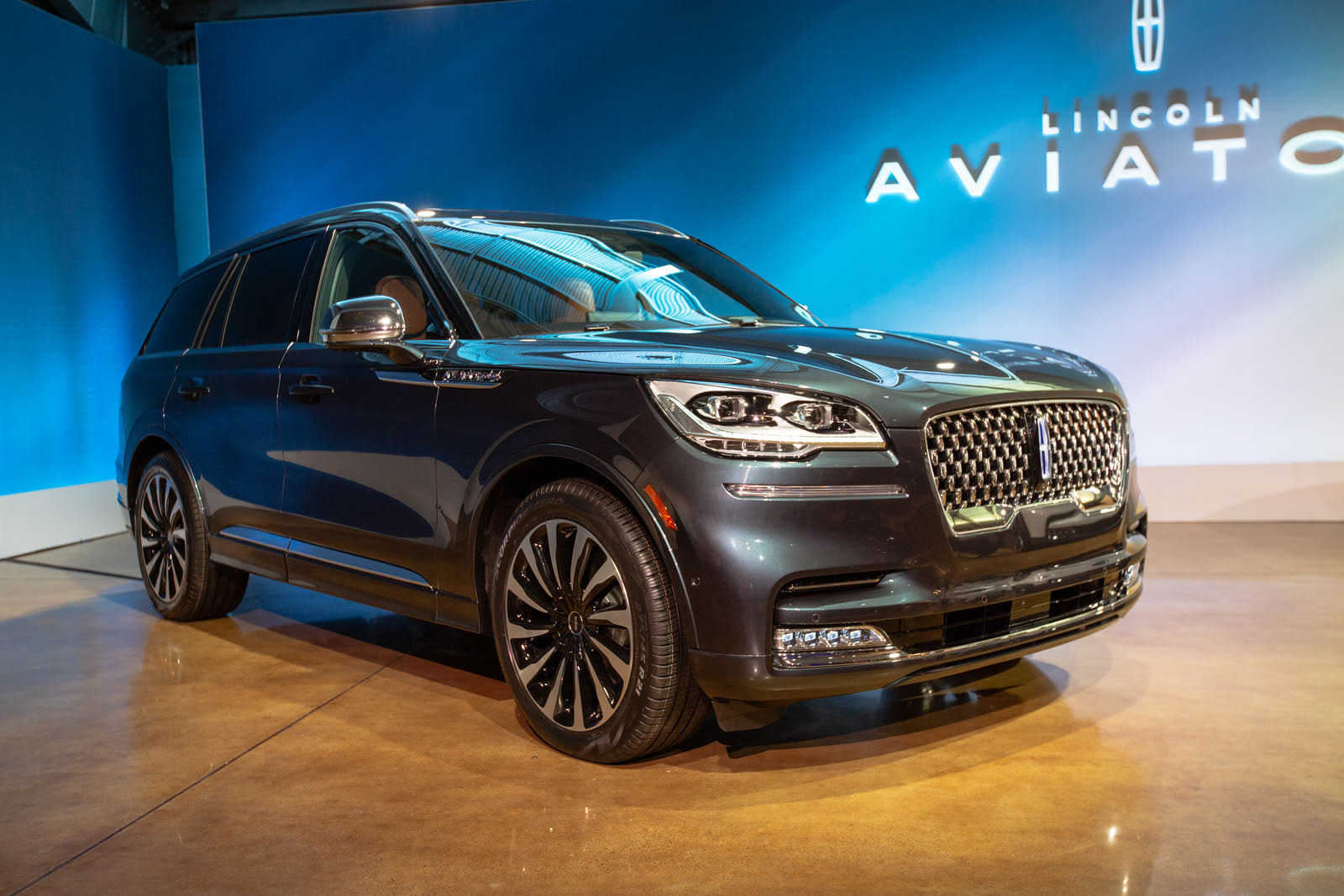
According to CarGurus experts, the overall rating for the 2019 BMW X5 is 7.8 out of 10, while the 2020 Lincoln Aviator scores 8.2 out of 10. Based on these ratings, the 2020 Lincoln Aviator is the better choice, offering a more luxurious interior, user-friendly technology, and a higher overall rating.
Choose the 2020 Lincoln Aviator if:
- You want a luxurious interior with high-quality materials.
- You need a three-row SUV with ample cargo space.
- You prefer a user-friendly infotainment system with a large touchscreen.
Choose the 2019 BMW X5 if:
- You prioritize a smooth, sedan-like driving experience.
- You need a vehicle with strong towing capabilities.
- You value advanced suspension options for a customizable ride.
CarGurus highlights

According to CarGurus experts, the overall rating for the 2019 BMW X5 is 7.8 out of 10, while the 2020 Lincoln Aviator scores 8.2 out of 10. Based on these ratings, the 2020 Lincoln Aviator is the better choice, offering a more luxurious interior, user-friendly technology, and a higher overall rating.
Choose the 2020 Lincoln Aviator if:
Shop Now- You want a luxurious interior with high-quality materials.
- You need a three-row SUV with ample cargo space.
- You prefer a user-friendly infotainment system with a large touchscreen.
Choose the 2019 BMW X5 if:
Shop Now- You prioritize a smooth, sedan-like driving experience.
- You need a vehicle with strong towing capabilities.
- You value advanced suspension options for a customizable ride.

By: CarGurus + AI
At CarGurus, our team of experienced automotive writers remain at the heart of our content operation, conducting hands-on car tests and writing insightful guides that are backed by years of industry experience. To complement this, we are harnessing AI to make our content offering more diverse and more helpful to shoppers than ever. To achieve this, our AI systems are based exclusively on CarGurus content, ratings and data, so that what we produce is both unique to CarGurus, and uniquely helpful to car shoppers.

